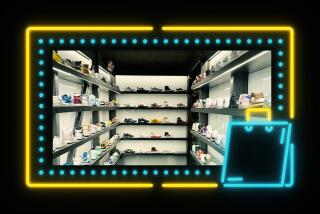Striking Gold Anew
- Share via
SONORA, Calif. — In this town of 4,400 in the middle of Mother Lode country, the Old West seems not so far away.
To one side, a mountain road that was once a stagecoach trail brushes by alpine lakes. To the other side lie a valley and streams, the area immortalized by Mark Twain in “The Celebrated Jumping Frog of Calaveras County.”
At the local Valliwide Bank branch, alongside the deposit slips lie the marked weights that once measured the prospectors’ gold dust. Although customer service manager Alice Riede insists that the bank no longer buys raw gold dust, it still uses a two-door, cast-iron combination vault of the type Butch Cassidy and the Sundance Kid once favored blowing up.
Progress has come slowly to Sonora, although it has been speeding up of late. When Buzz Eggleston, managing editor of the city’s 142-year-old daily, the Union Democrat, got here 10 years ago, Sonora had only one stoplight. Now, he mourns, it has a dozen.
And when progress did come, it threatened the lingering death common to many small towns.
Sonora’s turning point came seven years ago when it ran a half-million-dollar deficit. Some town officials took a 50% pay cut to help close the gap.
Even as municipal coffers drained low, however, officials turned to stave off the threat posed by the impending arrival of Wal-Mart, Mervyn’s and other retail chains. Elsewhere, these chains drained customers away from Main Street to the suburbs.
But Sonora had an unusual asset. It is the Tuolomne County seat, with about 20,000 people pouring in every workday to transact business, quintupling the town’s daytime population.
So what if the town could somehow position itself to capture these visitors’ tax dollars? What if, instead of fighting off the retail chains, Sonora welcomed them--insisting, in fact, that the chains should not locate in the outlying areas but in the town itself?
Thus, out of sight of historic Washington (“Main”) Street but still within the town’s borders, Sonora planned a shopping center. “We knew that if we forced these mass merchants to the suburbs, we’d have higher policing and related costs, with few benefits,” explained Mayor Jack Rucker, 79. “By locating in Sonora, we’d get the benefits.”
It worked. The 7.25% sales tax soon provided a veritable deluge of revenue--fully a third of the town’s income. Thus, even as the Jamestown Gold Mines and Blue Shield shut down local operations, and even as the timber industry staggered under continuing layoffs, municipal revenues shot up.
Even after spending a record $763 per resident last year, twice as much as nearby Modesto and more than any other city in the area, Sonora ran up a $1.2-million surplus. Now, instead of the town worrying about how to avert bankruptcy, its problem became what to do with all its money.
The police have been among the first beneficiaries. Perhaps this was almost inevitable, given that the police station--supposedly the most secure building in town--was a decrepit wooden structure. Shoot a rifle bullet through one end and it would probably come out the other.
Not any more. Not only are police headquarters larger and bulletproof, they are more modern than the LAPD’s, said Police Chief Michael Efford. Sonora equipped its officers with lapel mikes, a la “Star Trek,” so that an officer leaving his patrol car can remain in voice contact with his base, even if both hands are wrapped around his new Beretta.
The V-shaped light bars atop Sonora’s police cars can illuminate a 360-degree search perimeter. And while older LAPD cars have rear seats with cushions where a suspect can conceal drugs, the rear seats in Sonora’s new Ford LTDs are made of molded black plastic.
That way, Efford said, the suspect can no longer conceal evidence or lie down and hide from an officer while drawing out a concealed weapon.
Not surprisingly, morale at the Sonora Police Department is now riding high, with applicants from the LAPD sounding out the possibility of a job there, Efford said.
Next in line for modernization: the Fire Department. City Hall is also about to undergo a top-to-bottom remodeling. In addition, Sonora is rehabilitating its swimming pool and planning a state-of-the-art, 15,000-square-foot skateboard park--the only one in the Mother Lode area--whose highlight will be a winding center path called a snake.
Best of all, a spruced up and well-patrolled Washington Street is once more booming. Even businesses that had closed have reopened.
“So many tourists are coming through that merchants are staying open weekends and late evenings. And because there are more people on the streets, they are spending more, which brings in more revenue,” Rucker said.
And yet, Sonora has not been able to eliminate the hard times faced by many. “Unemployment may be at a seven-year-low nationwide, but not here,” said Jeff Fitzwater, vocational counselor with the federally funded Mother Lode Job Training Program. “Here it isn’t even like the rest of California. Here it’s a whole different ballgame.”
Fitzwater sees Sonora and the surrounding areas continuing to lose higher-paying jobs, which are being replaced by part-time, minimum-wage work provided largely by the incoming chain stores. “A lot of people here are commuting to the (San Joaquin) valley or leaving town, even moving out of state just to get work. It’s a great place to live, but hard if you want to support a family,” he said.
And so the merchants prosper and the tax base grows, while the remaining job base shrinks. In short, Sonora has dodged the bullet --for now.
More to Read
Inside the business of entertainment
The Wide Shot brings you news, analysis and insights on everything from streaming wars to production — and what it all means for the future.
You may occasionally receive promotional content from the Los Angeles Times.










